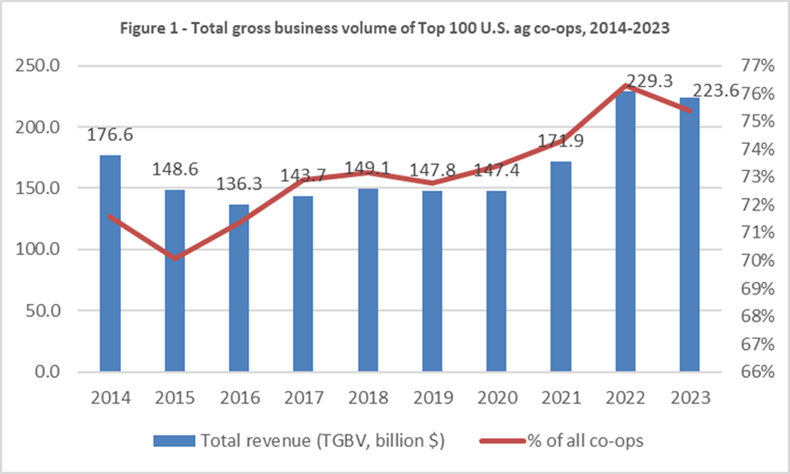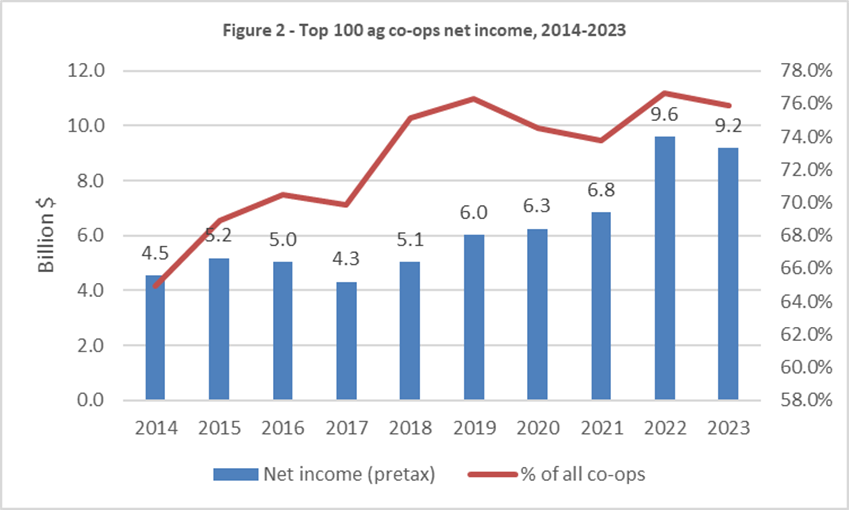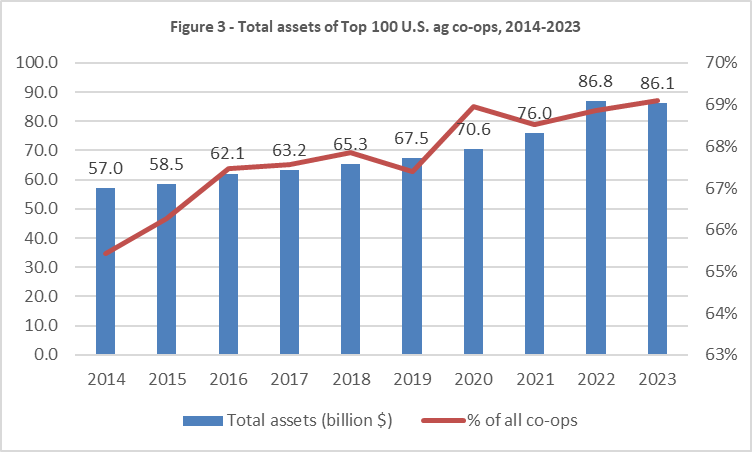
October is National Cooperative Month!
USDA’s Top 100 Ag Co-ops for 2023
Top 100 agricultural cooperatives have solid results in 2023, even with dips in revenues, income, and assets
October 10, 2024
The business volume of the nation’s Top 100 agricultural cooperatives (i.e., the 100 largest in terms of business volume) was $223.6 billion in 2023, a decrease of $5.7 billion, or 2.5 percent, from the record $229.3 billion in 2022. These top co-ops also reported slight drops in net income and total assets for 2023, at $9.4 billion (before taxes) and $86.1 billion, respectively. Net income before taxes dropped by $175 million (1.8 percent) from the record of $9.6 billion in 2022 (Figures 1 and 2). Total assets decreased by $612 million from 2022 to 2023.
 Even though the Top 100 co-ops experienced drops in overall volume and income, they still experienced strong performance. Cost of goods sold was lower and expenses fell, while patronage received from other cooperatives increased as did non-operating revenues.
In 2023, total gross sales (sales from marketing commodities and selling supplies) dropped from $225 billion to $219 billion. Revenues from marketing commodities decreased by $5.3 billion to $142.1 billion, while supply sales fell by $687 billion to $76.9 billion for the Top 100 ag co-ops.
For expenses, wages and other expenses decreased, while depreciation and interest expense increased. Together, total expenses dropped by $532 million (2.9 percent) to $17.5 billion. The Top 100 co-ops paid $9.1 billion in wages and benefits to their employees in 2023 (down $61 million from 2022).
The Top 100 ag co-ops had 75.9 percent of the total gross business revenues of all ag co-ops in 2023. Total gross business revenues are comprised of gross sales, service and other operating revenues, patronage from other cooperatives, and non-operating income. Net income after taxes ($9.2 billion) of the Top 100 was 78.0 percent of all ag co-ops.
 The $86.1 billion in total assets of the Top 100 ag co-ops in 2023 was a decrease of just 0.7 percent from 2022 (Figure 3). Fixed assets increased by 5.2 percent to $24.9 billion in 2023, and investments in other cooperatives also increased, by 4.0 percent, to $2.7 billion.
Total liabilities of the Top 100 ag co-ops dropped by 6.3 percent to $47.6 billion in 2023 (long-term liabilities increased by $808 million, or up by 5.2 percent). Member equity was a record $38.6 billion, of which 56.5 percent ($21.8 billion) was equity allocated to members.
Total assets of the Top 100 were 69.1 percent of the total assets of all ag co-ops, while member equity was 66.3 percent of all co-op equity.
 Profile of the Top 100
The 100 largest ag co-ops reported serving 665,582 members and employing 110,450 people in full- and part-time positions (both figures were up from 2022). Compared to the entire population of the Nation’s ag co-ops, the largest 100 co-ops (6 percent of the total 1,647 ag co-ops) served 37.0 percent of all co-op members and employed 65.4 percent of the people.
Top 100 co-ops operated 4,323 locations (45.4 percent of all co-op locations) in communities across the United States. Thirty-three Top 100 ag co-ops have been operating for more than 100 years, 30 co-ops for 75 to 99 years, 15 co-ops for 50 to 74 years, and 22 for less than 50 years. The average size of the board of directors of Top 100 ag co-ops was 13, while the average size of boards of all ag co-ops was 8.
Most of the Top 100 ag co-ops (48 of them) have diverse operations, noted as mixed type co-ops with varying combinations of commodities marketed and supplies sold. There were 17 co-ops in the Top 100 that marketed milk and milk products (dairy), 14 marketed grain and oilseeds, 5 marketed fruits and/or vegetables, and 4 marketed sugar. Six more were supply co-ops, 3 were livestock, and 6 co-ops were in the other category (i.e., commodities including rice, cotton, and nuts).
Iowa, Minnesota, and California had highest Top 100 ag co-op sales
Seventy of the 100 largest ag co-ops operate in more than one State, 70 of those operate in more than 2 States, and 36 of them operate in more than 3 States. The other 30 co-ops operate within just one State.
- Iowa had 37 Top 100 ag co-ops operating within its borders which conducted $26.4 billion in net sales, a combination of $17.8 billion in commodities marketed and $8.6 billion in supply sales.
- Minnesota had $16.6 billion in net sales conducted by 33 Top 100 ag co-ops.
- California had 12 co-ops with $12.8 billion in net sales.
- Illinois ($11.3 billion) and Nebraska ($10.0 billion) also topped $10 billion in sales, by 24 and 18 Top 100 co-ops, respectively.
When breaking out commodities marketed, Iowa had the most marketing net sales of the Top 100 ag co-ops at $17.8 billion, and California and Minnesota followed with $12.4 billion and $11.6 billion, respectively. For supplies, the Top 100 ag co-ops had the most net sales in Iowa at $8.6 billion, followed by Minnesota with $5.0 billion, and Illinois with $4.9 billion.
For 2023, net sales of the 100 largest ag co-ops (at $189.4 billion) was slightly lower than 2022’s $191.7 billion, with $137.7 billion coming from marketing commodities and $51.7 billion coming from supply sales in 2023. These co-ops also conducted $29.6 billion in business between themselves, and when added to net sales, resulted in the total $219.0 billion in gross marketing and supply sales of the Top 100 co-ops.
CHS, Inc. again ranked first in the USDA Top 100 ag co-op list
CHS Inc., Inver Grove Heights, Minnesota—an energy, farm supply, grain and food co-op—is the nation’s largest agricultural co-op (in fact, it is the largest U.S. co-op of any kind) and has held that position for many years. In 2023, CHS had total gross business revenue of $46.4 billion and total assets of $19.0 billion. Dairy Farmers of America, a dairy co-op headquartered in Kansas City, Kansas, is in the 2nd position in the listing with total revenue of $21.7 billion and assets of $7.3 billion. Land O’Lakes of Saint Paul, Minnesota, a diverse supply, dairy, and food co-op is ranked third with $16.8 billion in total gross revenues and $9.5 billion in assets.
Tracking the Top 100
Tracking the Top 100 co-ops’ performance year-to-year provides insight into trends and economic forces impacting ag co-ops and their member owners. The various financial ratios discussed may also serve as a yardstick that all co-ops can compare their own status to. In 2023, the Top 100 co-ops experienced relatively slight drops from the record business volume, sales, income, and asset levels that were reached in 2022.
However, the cooperatives had strong results and continued to show significant financial and operational strength.
Strong financial performance allows co-ops to invest in additional or renewed operational assets; use funds to shore up their financial foundation and to pay out patronage refunds and revolve member equity to members. The operations of the nation’s 100 largest agricultural cooperatives represent a wide diversity of agricultural businesses. As such, it is difficult to point to two or three reasons for the ranking changes that occurred within the list in the past year. While there are several reasons that a co-op’s rank, total business volume, revenue, expenses, and income may change on a year-to-year basis; these factors vary depending upon the sector the cooperative operates within. Total business revenue changes of a co-op can be influenced by:
- Prices and supply and demand conditions (for some commodities and supply inputs there were increases, for others decreases),
- Cooperative-sector structural changes, such as mergers and dissolutions and/or co-op participation in LLCs, joint ventures, and partnerships,
- Energy-sector performance, food-price fluctuations, trade circumstances,
- Crop, land, and weather conditions; etc.
It remains important to keep these and other factors in mind when assessing the rank and performance of the Top 100 U.S. agricultural co-ops.
While this analysis focused on the Top 100 ag co-ops, it does not diminish the importance of small- to mid-sized ag co-ops and their significant contributions to agriculture and the food and fiber system. All co-ops operate to effectively serve members, striving to provide them with excellent services and greater economic benefits than they would otherwise experience without their direct participation and ownership in their cooperatives. Together, ag co-ops of all sizes and types play a critical role in the agricultural economy of the United States and together, they all positively impact rural and urban communities, the labor market, and farmers and consumers throughout the Nation.
Full 2023 Top 100 Ag Co-ops Bulletin Complete with Tables is Available
This bulletin was developed from the information contained in a more comprehensive bulletin that is available in .pdf format. The full bulletin contains the same charts shown here, but also 8 tables, including the listing of the individual Top 100 ag co-ops for 2023. To receive a copy of the full Top 100 bulletin, please email your request to coopinfo@usda.gov.
Bulletin Link: https://content.govdelivery.com/accounts/USDARD/bulletins/3bb05da
|
Signup for USDA emails and updates GovDelivery (select cooperative development topic areas)
|
USDA Rural Development
Cooperative Services Branch
Interagency Working Group for Cooperative Development
|